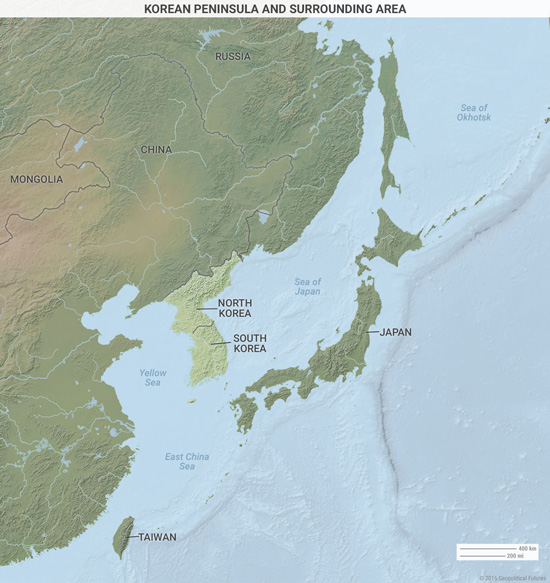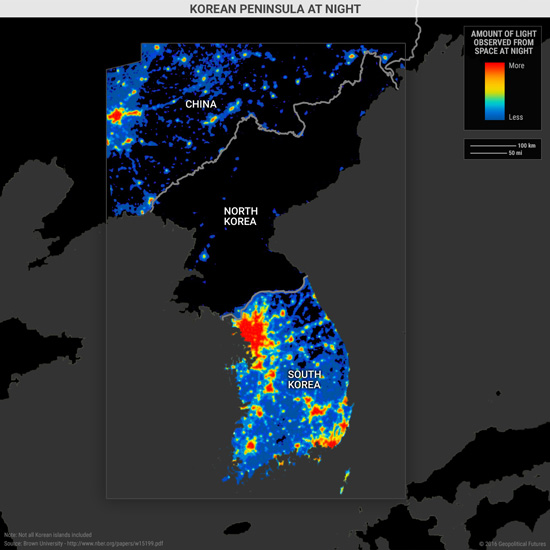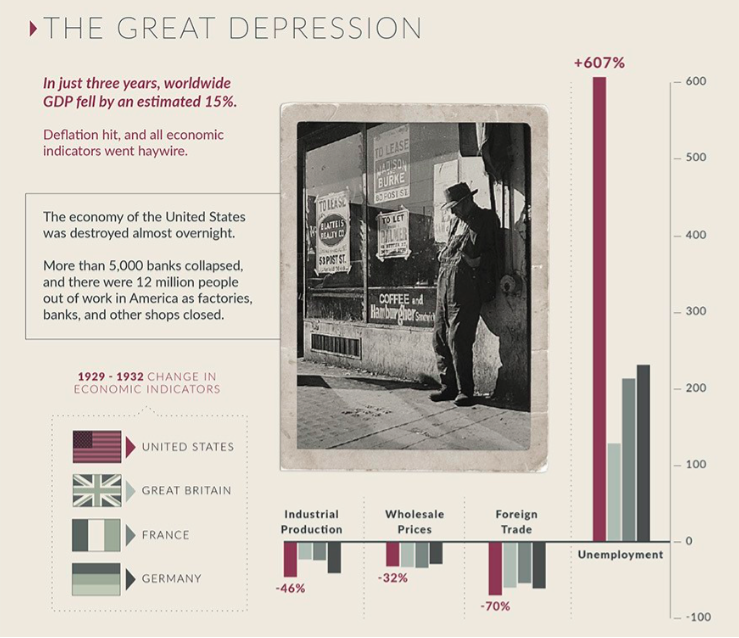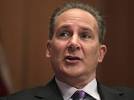Economic Outlook
To understand North Korean strategy today, we must first understand the implications of its geography. Korea is a peninsula jutting southward from Manchuria. The waves of the Yellow Sea break on its western shores, and the waves of the Sea of Japan roll in on its eastern flank. It shares a 30-mile-wide border with Russia, its northeastern border about 70 miles from Vladivostok, Russia’s major eastern port. The southeast corner of Korea juts to within 100 miles of Japan to its south, and the peninsula’s southwest corner angles westward only about 300 miles from Shanghai. In hostile hands, Korea can threaten Japan’s access to the East China Sea and the Pacific from the Sea of Japan. Korea can also potentially interfere with China’s access to the Yellow Sea and potentially to Shanghai.
Japan and China have invaded the Korean Peninsula on several occasions. Its geographical position and size relative to Japan and China made these incursions inevitable. From the Chinese point of view, Korea served as Japan’s axis of advance in China. From Japan’s point of view, if a hostile power were to hold Korea and thereby gain access to the Sea of Japan, it could threaten maritime trade and open the door to invasions of the home islands from the west and the east. When the peninsula was in Japanese hands, Manchuria and the Russian maritime regions, including Vladivostok, were threatened.

The Korean Peninsula poses a potential threat to three major powers, not because of what any government on the Korean Peninsula might do, but simply because of its geographical position. [https://geopoliticalfutures.com/forecasts/the-world-in-2016-2/] For that reason, it has been invaded by both China and Japan at various points throughout history and by the Soviet Union and the United States in the 20th century. The motivation behind the invasions has not been so much to capture the wealth of Korea, which was minimal, as it has been the fact that the country can provide strategic springboards or blocks to major powers. Korea was a critical piece in any Chinese or Japanese strategy.
The end of World War II did not reduce Korea’s importance. It simply eliminated one player, Japan, and introduced a new one, the United States. The American presence in Korea was not actually new. In 1871, the Americans sent a delegation to open trade relations with Korea. While the talks were going on, Korean shore batteries opened fire on American warships that had accompanied the delegation. This conflict culminated in a battle between US sailors and Marines and Korean troops that killed about 200 Koreans and three Americans.
This incident would have created long-lasting enmity, except that the Japanese began in 1876 a process of annexing Korea that culminated in the formal Japanese occupation of the country in 1910. That occupation wiped away any residual resentment of the United States, as the Japanese occupation was, by contrast, brutal and demeaning. Seventy years after the occupation ended, it remains a bitter historical memory for the Koreans.
The defeat of Japan in World War II ended Japanese hegemony over Korea. The Yalta Conference created a four-power joint government in Korea, but that coalition failed, as did a similar joint government in Berlin. As in Berlin, Korea was divided, with Soviet troops and their Korean supporters occupying the land north of the 38th parallel and the Americans and their Korean supporters occupying the south.
The United States did not see South Korea as a critical strategic asset, but the Soviets and the Chinese saw an opportunity. The Soviets had suffered a defeat in Berlin when their blockade failed because of the American airlift. They also saw Korea as a threat to Vladivostok should the US regain interest. The Chinese were similarly concerned about a later shift in American interest and wanted to expel the Americans from the peninsula. The fact that doing so would also increase pressure on the United States in Japan was another consideration. Japan was critical to America’s successful containment of Russia, as Japan effectively blocked Soviet access to the Pacific from Vladivostok. A Soviet naval base at Busan, Korea, might pose as both an offensive threat and a defensive solution. Again, it was Korean geography that mattered.
The North Korean invasion of South Korea in June 1950 took the United States completely by surprise: US intelligence had failed to detect North Korea’s act of aggression on the ground. President Harry Truman faced a critical decision. Technically, Korea was not critical to US national security. But Truman calculated that Korea’s strategic position would protect Japan, and defending South Korea would make clear that the United States would resist open aggression. Truman’s decision, made in a weekend, created modern northeast Asia by making the United States the guarantor of South Korean national security. [https://geopoliticalfutures.com/the-meaninglessness-of-missile-defense-in-south-korea/] Two imperatives drove Truman—one geopolitical and the other psychological. His decision also demonstrated the importance of studies and position papers. In the end, a US president is sometimes compelled to act because he feels the overwhelming force of reality.
The war began with the North Koreans nearly taking South Korea. A defensive perimeter was forged around Busan, and reinforcements rushed in to hold it. The North Koreans were driven back, and then General Douglas MacArthur executed an amphibious landing at Incheon, cutting off the North Korean military and shattering it. He crossed the 38th parallel and moved north.
The Korean Peninsula is designed for defense. It is narrow—about 200 miles wide at its narrowest—and about 500 miles long. It is also covered with very rugged hills. A relatively small force, using the rugged terrain cleverly, can hold off a larger force, retreating slowly and inflicting casualties on the attacker, who has to come out from under cover. The first attack from the north had come as a surprise, driving an inferior and poorly prepared South Korean force back. In their counterattack, MacArthur’s forces did not slog through those treacherous hills but flanked the defending North Koreans by sea.

As the Americans moved rapidly forward, they approached the Yalu River in the northeast. Their advance threatened both the Chinese and the Russians, who could not accept a large American force along their borders. Therefore, the Chinese—again to the surprise of US intelligence—drove a large force southward, pushing the Americans back. The initial Chinese attack resulted in a rout, but in the end, the Americans were able to stabilize their position and impose heavy casualties on the Chinese, ending the war in an armistice that looked much like the status quo prior to the war.
War is extremely difficult to wage on the Korean Peninsula. During temporary positions of surprise or imbalance, it is possible to drive the defender back. But the Korean War showed that, while it is possible to drive the enemy back, it is not possible to simply wipe it out. One reason is the terrain; another is the strategic reality that no major regional power can afford to allow the peninsula to fall completely into the hands of a hostile power.
This set of dynamics created the current situation in Korea. The peninsula is divided into two states—one with the full support of the United States, the other at the moment in a much more complex relationship with China, its traditional patron. South Korea has emerged as one of the major industrial powers in the world. One reason for its economic success is the American grand strategy of maintaining a long-term commitment to defend South Korea. However, a strategic relationship with the United States carries with it both benefits and risks. The major risk is war. The major benefit is that the US tilts the table in favor of the client state.
North Korea’s relationship with China and Russia has not resulted in similar benefits.

The map above displays light visible from space at night. South Korea is ablaze, China less so but with intense areas. North Korea, on the other hand, is virtually without light, or to be more precise, without enough clustered lighting to be seen from space. Thus, while both South Korea and North Korea were devastated by the Korean War, South Korea has transformed into a modern industrial power, while North Korea appears to be preindustrial—or so it appears, based on nighttime lighting.
How did this disjuncture occur? The Chinese and Russians had fewer resources to invest in North Korea than the US had to invest in the south. But the complete answer must be somewhat more complex. Even on their own, the North Koreans should have been able to generate greater economic growth than they have. And certainly, after the fall of the Soviet Union, the Chinese could have aided North Korea more fully had they wished to do so.
The rest of the answer has to do with the nature of the North Korean regime. The first strategy of any state is its preservation. North Korea was faced with a major US force and an increasingly powerful South Korean force. The logical thing would have been for the Chinese and Soviets to create an equivalent force. They chose not to.
The Chinese and Russians did not want a powerful North Korea; they wanted a buffer state between themselves and American forces in the south. They wanted a North Korea strong enough to deter an American attack, and they wanted the regime to survive. But as always, a strong North Korea could face two ways. In its current configuration it faced south. With regime change it could face north. Therefore, the Russians and the Chinese, split though they were during the latter part of the Cold War, together created a paradox in North Korea. They sought to retain a regime that blocked any American adventures northward and put the South Koreans and the Americans on the defensive. They did not want the regime to fall and thus create a vacuum that could create an opening for the Americans, but they also didn’t want North Korea strong enough to threaten them.
Both the Soviets and Chinese understood that simply being communist was no longer sufficient grounds for an alliance. The Soviets and Chinese had become enemies in spite of a shared ideology. Neither wanted the other to use North Korea as a tool against it. We should add that South Korea and the United States themselves were not eager to see the North Korean regime fall. South Korea did not want to bear the expense and risks involved in reintegration. The United States was content with the status quo in the Korean Peninsula, as its primary interest there was minimal conflict. And out of this paradoxical strategy emerged the contemporary North Korean state.
As the Soviet Union fell China moved toward a more liberal economy, and North Korea was placed in a difficult position. Its primary strategies of regime survival and blocking both the Americans and the South Koreans remained intact. But reliance on its communist partners became more difficult and complex. One partner was no longer communist, and the other was increasingly unpredictable. North Korea could not emulate China and still guarantee regime survival, and the forces that had transformed its partners might be lurking in North Korea as well.
As a result, North Korea was forced to lock in its policy of intense hostility to the south and to ramp up already extreme measures to preserve the regime, defending it from both external and internal forces—even forces within the ruling family. Its strategy became one of bluffing. A game of bluff requires utter discipline and no dissension. The North Koreans sought to frighten the Americans and South Koreans by pretending to be irrational and on a hair trigger. [https://geopoliticalfutures.com/the-use-of-irrationality-in-foreign-affairs/] The leadership sought to convince the North Korean public that there was no external threat it could not crush, because of its enormous strength. What appeared to the world as entirely irrational behavior was, given North Korea’s strategic needs, quite rational.
North Korea had a massive army but not a good one. Its weapons and tactics were generations out of date. It had one advantage—geography. Seoul, the South Korean capital, now a modern metropolis, lay within artillery range of North Korea. The north massed its forces on the border and threatened that in the event of a conflict (which it insisted it would trigger if provoked), it would shell the massive metropolitan area and move its tanks south to occupy the city. By the numbers this was possible, but the North Korean military on the move would be extremely vulnerable to air power. Still, sheer proximity meant that an irrational move could do significant damage.
North Korea also needed a more credible threat than its massed force begging for a carpet bombing. This need engendered its nuclear program. [https://geopoliticalfutures.com/the-significance-and-insignificance-of-a-north-korean-hydrogen-bomb/] The program enhanced the consequences of irrational action. It was an obvious bluff, since resorting to a nuclear attack would guarantee the annihilation of the regime—and possibly the nation. Rationally speaking, North Korea couldn’t possibly launch a nuclear strike. Therefore, it was critical for North Korea to appear irrational. Only apparent irrationality, meticulously managed, could convince the Americans, South Koreans, Japanese, Russians, and Chinese that North Korea was utterly dangerous. But the regime’s apparent irrationality had to be calibrated in such a way th at North Korea’s dangerousness was never so credible or imminent that someone would preemptively attack it. It had to preserve the regime and paralyze its opponents without forcing military action by its adversaries.
North Korea had two enormous advantages in this strategy. First, no one really cared enough to act. The South Koreans didn’t want to incur the cost that Germany bore when it integrated the post-communist east. The US was not eager for the instability that would be created by a North Korean collapse, nor were the Japanese or Russians. And the Chinese were using their apparent ability to soothe the irrational North Koreans to extract concessions on other issues from the Americans. Everyone was content with the North Koreans as they were. Second, the North Korean regime worked. Instead of fragmenting and morphing as other communist regimes had done, the North Korean regime became locked into a model that was extremely effective in its unique strategic situation.
There is a permanence to the current North Korean situation that many underestimate. [https://geopoliticalfutures.com/forecasts/envisioning-2040-2/] South Korea has far more important matters, such as its own massive economy, to worry about. [https://geopoliticalfutures.com/signs-of-political-instability-in-south-korea/] North Korea must avoid a preemptive strike on its nuclear facilities, since its conventional military options would be unsustainable. The major partners understand North Korea well enough to endure its assertions of power and aggression without panicking. The regime appears resilient and in control. The result is a formula for stalemate… a stalemate of the indifferent.
But the cost of this stalemate is the blackness of the North Korean night. The cost of maintaining the regime is a dramatic lack of economic development. What wealth that exists is diverted to maintaining the bluff, which in turn requires a delicate internal balance that demands not only massive repression but also, above all, isolation. Contact with the rest of the world would be destabilizing, and so North Korea must limit that contact, resulting in cultural as well as physical darkness. And the night will not pass quickly. The dark night is what makes North Korea possible. It allows the bluff to go on and with it the regime.
As ever, for the rest of the world Korea—now North Korea—is a place used strategically to block the ambitions of others. Few want anything from it other than for it to continue to buffer greater powers. And even if fulfilling this purpose requires North Korean leadership to occasionally seem frightening by appearing irrational, those who watch North Korea know that its frightening aspect is tightly controlled by a calculating regime.

George Friedman
Editor, This Week in Geopolitics![]()

 The economy of the United States was destroyed almost overnight.
The economy of the United States was destroyed almost overnight.
More than 5,000 banks collapsed, and there were 12 million people out of work in America as factories, banks, and other shops closed.
Many reasons have been supplied by the different economic camps for the cause of the Great Depression, which we reviewed in the first part of this series.
Regardless of the causes, the combination of deflationary pressures and a collapsing economy created one of the most desperate and miserable eras of American history. The resulting aftermath was so bad, that almost every future Central Bank policy would be designed primarily to combat such deflation.
…view and read more HERE

 The theme of divergence has been playing out in the global economy. One example is how the US Federal Reserve has begun their path of gradually raising interest rates whereas central banks like the Bank of Japan or European Central Bank have acted in recent months to lower policy interest rates and provide further economic stimulus through quantitative easing. Another, in the United Kingdom there is talk of a “Brexit” where citizens will vote in a referendum this June whether to remain a part of the European Union. Even in Canada we see divergence in the form of how the BC economy performs compared to the rest of the country.
The theme of divergence has been playing out in the global economy. One example is how the US Federal Reserve has begun their path of gradually raising interest rates whereas central banks like the Bank of Japan or European Central Bank have acted in recent months to lower policy interest rates and provide further economic stimulus through quantitative easing. Another, in the United Kingdom there is talk of a “Brexit” where citizens will vote in a referendum this June whether to remain a part of the European Union. Even in Canada we see divergence in the form of how the BC economy performs compared to the rest of the country.
Over the course of 2015, as commodities prices continued to tumble, the Canadian energy sector has had a net negative effect on the countries labour market. The province of Alberta lost more jobs last year than they did in 1982 when they were in recession. BC on the contrary, has seen employment growth of 3 per cent in the twelve months trailing February 2016. It leads the pack of Canadian provinces and is one of three to actually add jobs over the last year. Parts of this country are very challenged with economic opportunity while other regions are forecasted to show modest growth.
This in itself presents a very difficult challenge for the new Federal Liberal government as we begin to examine and digest the details of their first budget over the next couple of months. There are very clear have and have not regions of this country, and they must insure stimulus spending is (to quote Harvard economist Larry Summer’s) “targeted, timely, and temporary.”
Of the three T`s, all imply their own level of importance, but I`ll expand on the notion of being temporary. Whether the government runs a deficit amounting to half a percent or full percent of GDP is really inconsequential in the short run. That being said, TD`s Economics department updated their projections for the Fed`s budget with the latest data from the Finance Department and found from their estimates they are on track for run deficits totalling 150 billion over the next five years. This would in-fact twice break a Liberal promise of first capping deficits at 10 billion per annum and then second keeping the debt-to-GDP ratio fixed. This risks government spending creating negative connotations for returning to economic growth over the long run and having a debt that runs away like during the late 1980`s and early 1990`s.
Thankfully Canadian politics have exhibited a level of civility that is absent in most other western nations making headlines at the moment, and our new government has been given a mandate to spend as they see fit to reignite the Canadian economy. As BC`s forecasted to be most prosperous province through 2016 though we should hope for two things. The first being that the fiscal stimulus measures of the federal budget can provide an effective temporary lift to the Canadian economy. But, the second is certainly be careful what we wish for as the risks to over spending mean either higher taxes down the road or higher deficits bigger than planned as the government gets itself mired in debt.


 Earlier today, we explained why so-called “helicopter money” can’t save the world when ZIRP, NIRP, and QE have all failed to revive global demand and boost inflation.
Earlier today, we explained why so-called “helicopter money” can’t save the world when ZIRP, NIRP, and QE have all failed to revive global demand and boost inflation.
The reason: QE is helicopter money. That is, we’ve been doing this for 8 years and it hasn’t worked yet.
Some readers were reluctant to buy this rationale, but the fact is, just because the bank intermediary failed to do its part for Main Street doesn’t thereby mean this entire experiment isn’t still a farce. Think about the mechanics of it: 1) the government prints a liability (a bond), 2) that liability is sold to a primary dealer, 3) the central bank buys that government liability with yet another liability (dollars) that the government also prints.
That’s a scam. It’s deficit financing with one (very tenuous) degree of separation. The fact that the middlemen (the banks) didn’t pass along the benefits to you doesn’t make the mechanics of it any less ridiculous.
But if that’s helicopter money “v.1,” Main Street thinks it didn’t work out so well. Banks recovered, Jamie Dimon and Lloyd Blankfein became billionaires, financial assets soared, and everyday people got....continue reading HERE


 Also:
Also: 









